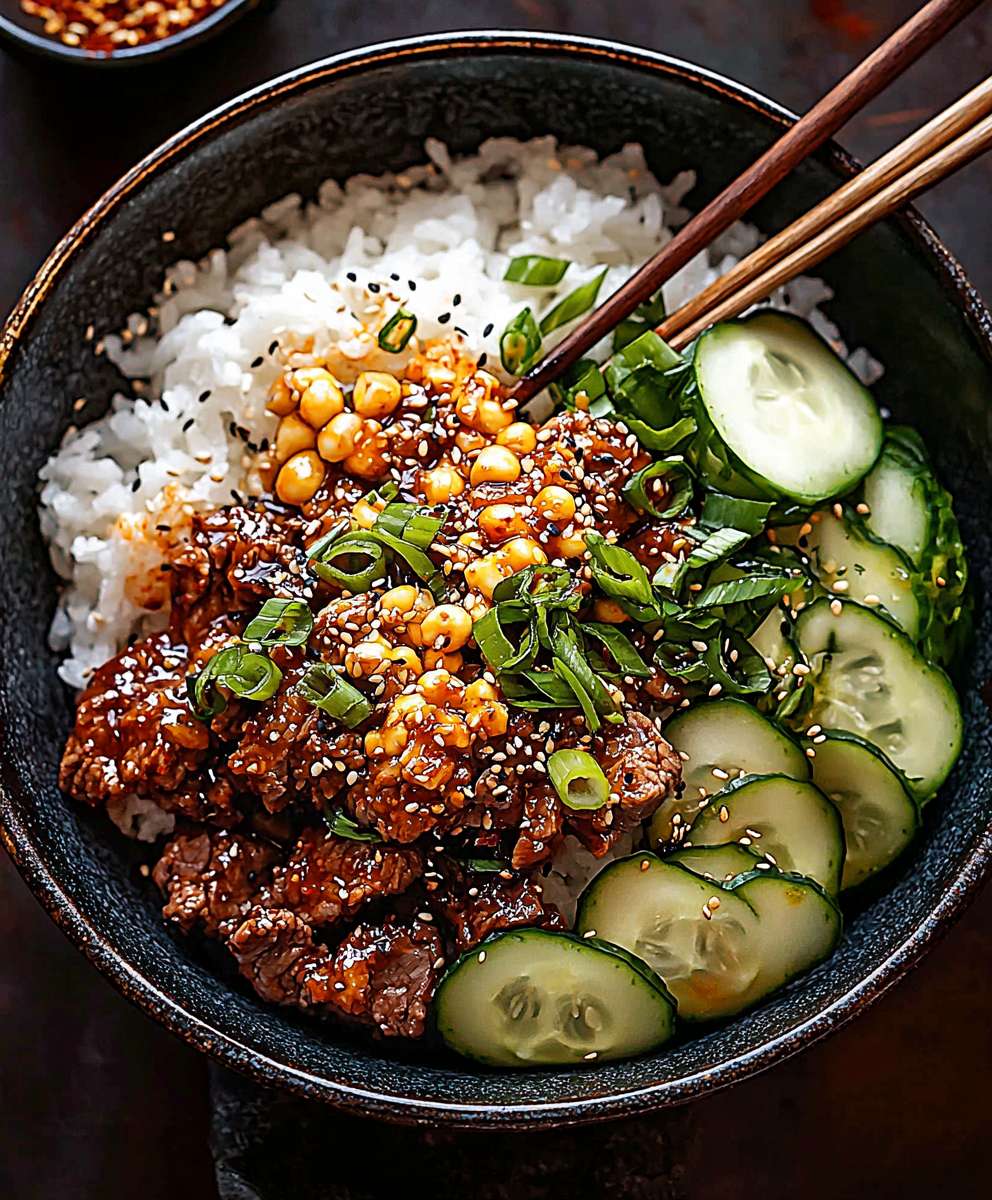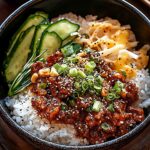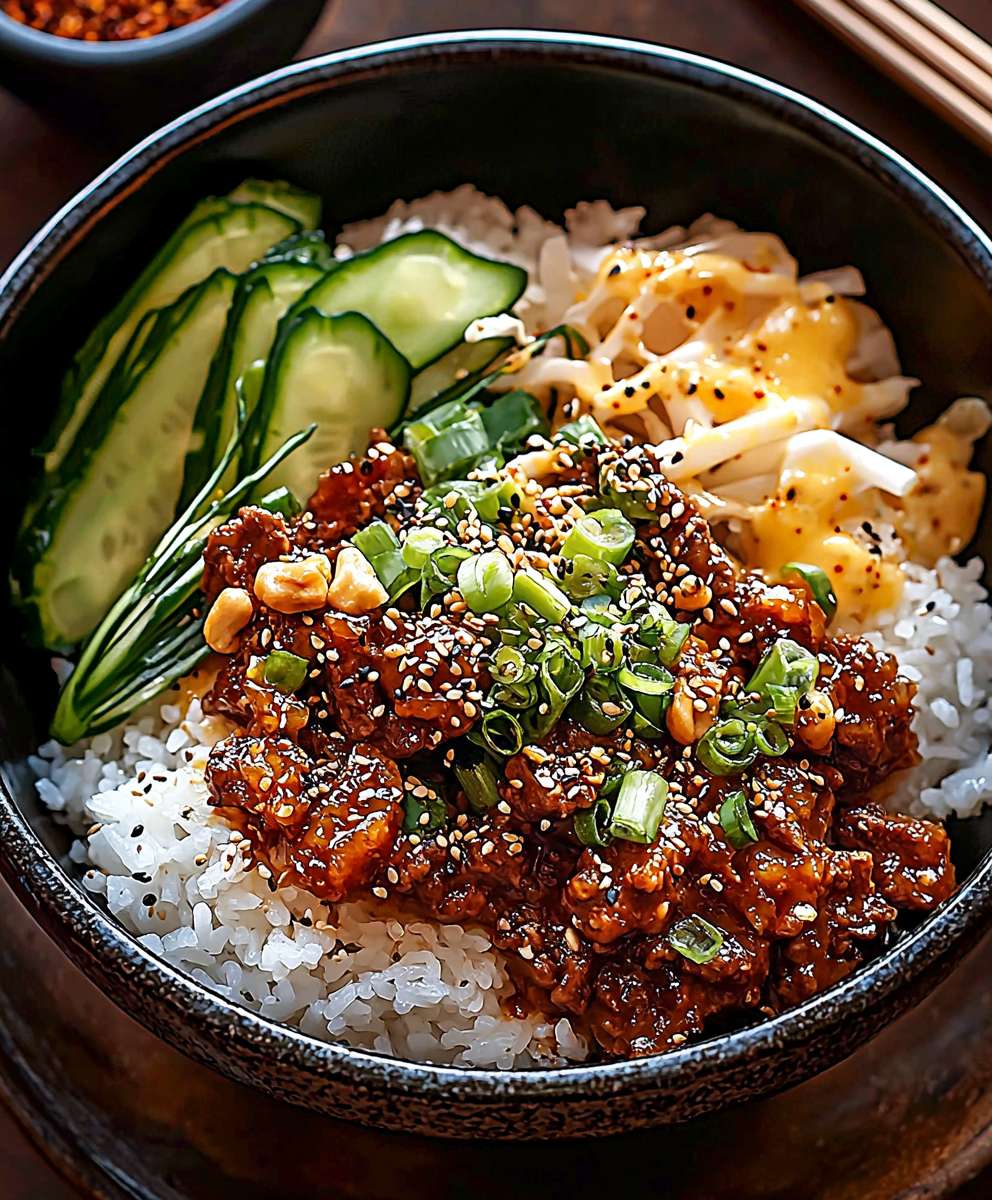Gochujang Beef Bowls: Prepare to embark on a culinary adventure that will tantalize your taste buds and leave you craving more! Imagine tender, savory beef, infused with the fiery kick of gochujang, nestled atop a bed of fluffy rice and vibrant, crisp vegetables. This isn’t just a meal; it’s an experience.
Gochujang, a fermented Korean chili paste, boasts a rich history dating back centuries. It was traditionally made in homes, passed down through generations, each family adding their unique touch to the recipe. This vibrant paste is more than just a condiment; it’s a symbol of Korean culinary heritage, representing warmth, community, and bold flavors.
What makes Gochujang Beef Bowls so irresistible? It’s the perfect harmony of flavors and textures. The sweetness of the beef beautifully complements the spicy, umami-rich gochujang. The crisp vegetables add a refreshing crunch, while the rice provides a comforting base. But beyond the taste, these bowls are incredibly convenient. They’re quick to prepare, making them ideal for busy weeknights, and easily customizable to suit your preferences. Whether you’re a seasoned cook or a kitchen novice, you can whip up a batch of these flavorful bowls in no time. So, are you ready to discover your new favorite weeknight dinner? Let’s get cooking!
Ingredients:
- For the Beef:
- 1.5 lbs ground beef (80/20 is a good choice for flavor)
- 2 tablespoons gochujang (Korean chili paste)
- 2 tablespoons soy sauce
- 1 tablespoon sesame oil
- 1 tablespoon brown sugar, packed
- 2 cloves garlic, minced
- 1 teaspoon ginger, grated
- 1/2 teaspoon red pepper flakes (optional, for extra heat)
- 1/4 cup water
- For the Rice:
- 2 cups uncooked jasmine rice (or your preferred rice)
- 4 cups water (or according to rice package directions)
- For the Quick Pickled Cucumbers:
- 1 English cucumber, thinly sliced
- 1/4 cup rice vinegar
- 2 tablespoons sugar
- 1 teaspoon salt
- For the Toppings (optional, but highly recommended!):
- 2 green onions, thinly sliced
- 1 carrot, shredded
- 1/2 cup kimchi, chopped
- 2 fried eggs (or poached, if you prefer)
- Sesame seeds, for garnish
- Sriracha or gochujang sauce, for extra heat (optional)
- Avocado slices, for creaminess (optional)
Preparing the Gochujang Beef:
- Brown the Beef: In a large skillet or wok over medium-high heat, brown the ground beef. Break it up with a spoon as it cooks. You want it to be nicely browned and crumbled. Drain off any excess grease. This is important for preventing a greasy final dish.
- Make the Gochujang Sauce: While the beef is browning, prepare the sauce. In a small bowl, whisk together the gochujang, soy sauce, sesame oil, brown sugar, minced garlic, grated ginger, and red pepper flakes (if using). Make sure the brown sugar is fully dissolved. This ensures even distribution of flavor.
- Combine Beef and Sauce: Once the beef is browned and drained, pour the gochujang sauce over it. Add the 1/4 cup of water. Stir well to coat the beef evenly with the sauce.
- Simmer and Thicken: Reduce the heat to medium-low and let the beef simmer for about 5-7 minutes, or until the sauce has thickened slightly and the flavors have melded together. Stir occasionally to prevent sticking. The sauce should cling nicely to the beef.
- Taste and Adjust: Taste the beef and adjust the seasoning as needed. If you want it sweeter, add a little more brown sugar. If you want it spicier, add more gochujang or red pepper flakes. If it’s too salty, add a splash of water.
Cooking the Rice:
- Rinse the Rice: Place the uncooked jasmine rice in a fine-mesh sieve and rinse it under cold running water until the water runs clear. This removes excess starch and helps prevent the rice from becoming sticky.
- Combine Rice and Water: In a medium saucepan, combine the rinsed rice and 4 cups of water (or follow the package directions for your specific type of rice).
- Bring to a Boil: Bring the mixture to a boil over high heat. Once it’s boiling, reduce the heat to low, cover the pot tightly with a lid, and simmer for 15-20 minutes, or until all the water has been absorbed and the rice is tender. Do not lift the lid during this time! This is crucial for even cooking.
- Rest the Rice: After 15-20 minutes, remove the pot from the heat and let it sit, covered, for another 10 minutes. This allows the rice to steam and finish cooking completely.
- Fluff the Rice: After the resting period, fluff the rice gently with a fork. This separates the grains and prevents them from clumping together.
Making the Quick Pickled Cucumbers:
- Prepare the Cucumbers: Thinly slice the English cucumber. A mandoline slicer works great for this, but a sharp knife will do the trick too.
- Make the Pickling Brine: In a medium bowl, whisk together the rice vinegar, sugar, and salt until the sugar and salt are dissolved.
- Combine Cucumbers and Brine: Add the sliced cucumbers to the bowl with the pickling brine. Toss to coat them evenly.
- Let it Sit: Let the cucumbers sit in the brine for at least 15 minutes, or up to an hour, in the refrigerator. The longer they sit, the more pickled they will become. Stir occasionally to ensure even pickling.
- Drain (Optional): Before serving, you can drain off some of the excess pickling liquid if you prefer.
Assembling the Gochujang Beef Bowls:
- Prepare Your Bowls: Grab your favorite bowls. I like using wide, shallow bowls for this.
- Add the Rice: Spoon a generous amount of cooked rice into each bowl.
- Top with Beef: Top the rice with a generous portion of the gochujang beef.
- Add the Pickled Cucumbers: Arrange some of the quick pickled cucumbers on top of the beef.
- Add Toppings: Now comes the fun part! Add your desired toppings. I highly recommend the sliced green onions, shredded carrot, chopped kimchi, and a fried egg. A sprinkle of sesame seeds adds a nice touch.
- Add Extra Sauce (Optional): If you like extra heat, drizzle some sriracha or gochujang sauce over the top.
- Enjoy! Dig in and enjoy your delicious and flavorful Gochujang Beef Bowl!
Tips and Variations:
Vegetarian Option:
To make this vegetarian, you can substitute the ground beef with crumbled tofu or plant-based ground meat. Just be sure to press the tofu well to remove excess water before cooking. You can also add some chopped mushrooms for extra umami flavor.
Spicy Level:
The spice level of this dish can be easily adjusted to your liking. If you’re sensitive to spice, start with a smaller amount of gochujang and red pepper flakes. If you like it really spicy, add more of both!
Make Ahead:
The gochujang beef and pickled cucumbers can be made ahead of time and stored in the refrigerator for up to 3 days. The rice is best served fresh, but you can also cook it ahead of time and reheat it in the microwave or on the stovetop with a little water.
Serving Suggestions:
These bowls are great for a quick and easy weeknight dinner. They’re also perfect for meal prepping. You can pack the rice, beef, and toppings separately and assemble the bowls when you’re ready to eat.
Other Topping Ideas:
Feel free to get creative with your toppings! Some other ideas include: bean sprouts, edamame, seaweed salad, radish slices, and a drizzle of mayonnaise.
Rice Alternatives:
If you’re not a fan of jasmine rice, you can use other types of rice, such as brown rice, basmati rice, or even quinoa.
Gochujang Substitute:
While gochujang is the key ingredient in this recipe, if you absolutely can’t find it, you can try substituting it with a mixture of sriracha, miso paste, and a touch of brown sugar. However, the flavor will not be exactly the same.

Conclusion:
This Gochujang Beef Bowl recipe isn’t just another weeknight dinner; it’s a flavor explosion waiting to happen! The savory, slightly sweet, and undeniably spicy kick of the gochujang sauce perfectly complements the tender beef, creating a dish that’s both satisfying and exciting. I truly believe this is a must-try recipe for anyone looking to add a little zest to their meal routine. It’s quick, easy, and packed with ingredients you can easily find at your local grocery store. But the best part? It’s incredibly versatile! While I’ve outlined my favorite way to prepare these bowls, feel free to get creative and make them your own.Serving Suggestions and Variations:
* Rice is your canvas: I love serving these bowls over fluffy white rice, but brown rice, quinoa, or even cauliflower rice work beautifully. For an extra layer of flavor, try cooking your rice in chicken or vegetable broth. * Veggie Power: Don’t be afraid to load up on the veggies! Sautéed bell peppers, onions, mushrooms, or even some quickly stir-fried bok choy would be fantastic additions. A sprinkle of sesame seeds and some chopped green onions always adds a nice touch. * Spice it up (or down): Gochujang can pack a punch, so adjust the amount to your liking. If you’re sensitive to spice, start with a smaller amount and add more to taste. For those who crave the heat, a drizzle of sriracha or a sprinkle of red pepper flakes will take it to the next level. * Egg-cellent Addition: A perfectly cooked fried egg on top adds richness and creaminess to the bowl. The runny yolk mixes with the gochujang sauce, creating an even more decadent experience. * Pickled Perfection: Quick-pickled cucumbers or carrots offer a refreshing contrast to the savory beef. Their tangy flavor cuts through the richness and adds a delightful crunch. * Lettuce Wraps: For a lighter option, ditch the rice altogether and serve the gochujang beef in crisp lettuce cups. This is a great way to enjoy the flavors without the extra carbs. * Noodle Bowl Variation: Toss the gochujang beef with your favorite noodles udon, soba, or even spaghetti would work well. Add some shredded carrots, bean sprouts, and a sprinkle of peanuts for a complete meal. I’m confident that you’ll love this recipe as much as I do. It’s become a staple in my kitchen, and I’m always looking for new ways to customize it. The beauty of this gochujang beef bowl recipe lies in its adaptability. It’s a fantastic base for experimenting with different flavors and ingredients, allowing you to create a dish that perfectly suits your taste. So, what are you waiting for? Gather your ingredients, fire up your stove, and get ready to experience the deliciousness of these Gochujang Beef Bowls. I can’t wait to hear what you think! Please, try this recipe, and don’t hesitate to share your creations and variations in the comments below. Let me know what you added, what you changed, and how you made it your own. Happy cooking! I am sure you will enjoy this recipe as much as I do. Print
Gochujang Beef Bowls: A Quick & Easy Recipe You’ll Love
- Total Time: 50 minutes
- Yield: 4 servings 1x
Description
Flavorful Gochujang Beef Bowls with quick pickled cucumbers, fluffy rice, and fresh toppings. A delicious and customizable Korean-inspired meal!
Ingredients
- 1.5 lbs ground beef (80/20 is a good choice for flavor)
- 2 tablespoons gochujang (Korean chili paste)
- 2 tablespoons soy sauce
- 1 tablespoon sesame oil
- 1 tablespoon brown sugar, packed
- 2 cloves garlic, minced
- 1 teaspoon ginger, grated
- 1/2 teaspoon red pepper flakes (optional, for extra heat)
- 1/4 cup water
- 2 cups uncooked jasmine rice (or your preferred rice)
- 4 cups water (or according to rice package directions)
- 1 English cucumber, thinly sliced
- 1/4 cup rice vinegar
- 2 tablespoons sugar
- 1 teaspoon salt
- 2 green onions, thinly sliced
- 1 carrot, shredded
- 1/2 cup kimchi, chopped
- 2 fried eggs (or poached, if you prefer)
- Sesame seeds, for garnish
- Sriracha or gochujang sauce, for extra heat (optional)
- Avocado slices, for creaminess (optional)
Instructions
- Brown the Beef: In a large skillet or wok over medium-high heat, brown the ground beef. Break it up with a spoon as it cooks. Drain off any excess grease.
- Make the Gochujang Sauce: In a small bowl, whisk together the gochujang, soy sauce, sesame oil, brown sugar, minced garlic, grated ginger, and red pepper flakes (if using).
- Combine Beef and Sauce: Once the beef is browned and drained, pour the gochujang sauce over it. Add the 1/4 cup of water. Stir well to coat the beef evenly with the sauce.
- Simmer and Thicken: Reduce the heat to medium-low and let the beef simmer for about 5-7 minutes, or until the sauce has thickened slightly and the flavors have melded together. Stir occasionally to prevent sticking.
- Taste and Adjust: Taste the beef and adjust the seasoning as needed. If you want it sweeter, add a little more brown sugar. If you want it spicier, add more gochujang or red pepper flakes. If it’s too salty, add a splash of water.
- Rinse the Rice: Place the uncooked jasmine rice in a fine-mesh sieve and rinse it under cold running water until the water runs clear.
- Combine Rice and Water: In a medium saucepan, combine the rinsed rice and 4 cups of water (or follow the package directions for your specific type of rice).
- Bring to a Boil: Bring the mixture to a boil over high heat. Once it’s boiling, reduce the heat to low, cover the pot tightly with a lid, and simmer for 15-20 minutes, or until all the water has been absorbed and the rice is tender. Do not lift the lid during this time!
- Rest the Rice: After 15-20 minutes, remove the pot from the heat and let it sit, covered, for another 10 minutes.
- Fluff the Rice: After the resting period, fluff the rice gently with a fork.
- Prepare the Cucumbers: Thinly slice the English cucumber.
- Make the Pickling Brine: In a medium bowl, whisk together the rice vinegar, sugar, and salt until the sugar and salt are dissolved.
- Combine Cucumbers and Brine: Add the sliced cucumbers to the bowl with the pickling brine. Toss to coat them evenly.
- Let it Sit: Let the cucumbers sit in the brine for at least 15 minutes, or up to an hour, in the refrigerator. Stir occasionally to ensure even pickling.
- Drain (Optional): Before serving, you can drain off some of the excess pickling liquid if you prefer.
- Prepare Your Bowls: Grab your favorite bowls.
- Add the Rice: Spoon a generous amount of cooked rice into each bowl.
- Top with Beef: Top the rice with a generous portion of the gochujang beef.
- Add the Pickled Cucumbers: Arrange some of the quick pickled cucumbers on top of the beef.
- Add Toppings: Add your desired toppings. I highly recommend the sliced green onions, shredded carrot, chopped kimchi, and a fried egg. A sprinkle of sesame seeds adds a nice touch.
- Add Extra Sauce (Optional): If you like extra heat, drizzle some sriracha or gochujang sauce over the top.
- Enjoy! Dig in and enjoy your delicious and flavorful Gochujang Beef Bowl!
Notes
- Vegetarian Option: Substitute ground beef with crumbled tofu or plant-based ground meat. Press tofu well before cooking. Add chopped mushrooms for extra umami.
- Spice Level: Adjust gochujang and red pepper flakes to your preference.
- Make Ahead: Gochujang beef and pickled cucumbers can be made ahead and stored in the refrigerator for up to 3 days. Rice is best served fresh.
- Serving Suggestions: Great for weeknight dinners or meal prepping.
- Other Topping Ideas: Bean sprouts, edamame, seaweed salad, radish slices, mayonnaise.
- Rice Alternatives: Brown rice, basmati rice, or quinoa.
- Gochujang Substitute: Sriracha, miso paste, and brown sugar (flavor will not be the same).
- Prep Time: 20 minutes
- Cook Time: 30 minutes

